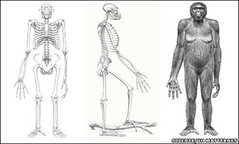Penmachine
02 October 2009
Ardi is another fascinating hominid fossil, but "missing link" no longer makes sense
 First, let's get something out of the way: the term missing link has long been useless, especially in human palaeontology. That's reinforced by this week's publication of a special issue of the journal Science, focusing on the 4.4-million-year-old skeleton of Ardipithecus ramidus, nicknamed "Ardi."
First, let's get something out of the way: the term missing link has long been useless, especially in human palaeontology. That's reinforced by this week's publication of a special issue of the journal Science, focusing on the 4.4-million-year-old skeleton of Ardipithecus ramidus, nicknamed "Ardi."
Chimpanzees are the closest living relative to human beings in the world, but our common ancestor lived a long time ago—at least 6 million years, likely more. When Charles Darwin proposed, some 150 years ago, that the fossil links between humans and chimps were likely to be found in Africa, he was right, but at the time those links really were missing.
It took a few decades until the first Homo erectus fossils were found in Asia. Since then, palaeontologists have found many different skeletons and skeletal parts of Homo, Paranthropus, and Australopithecus, with the oldest, as predicted, all in Africa. We've been filling in our side of the chimp-human family tree for over a century. (The chimpanzee lineage has been more difficult, probably because their ancestors' forest habitats are less prone to preserving fossils—and we're less prone to paying as much attention to it too.)
So it's been a long time since the links were missing, and the term missing link is now more misleading than helpful. Like "Ida," the 47-million-year-old primate revealed with too much hype earlier this year, "Ardi" is no missing link, but she is another fascinating fossil showing interesting things about our ancestry. Most notably, she walked upright as we do, but had a much smaller brain, more like other apes—as well as feet that remained better for climbing trees than ours.
None of that should be shocking. We shouldn't expect any common ancestor of chimps and humans to be more like either one of us, since both lineages have kept evolving these past 6 million years. Ardi isn't a common ancestor—she's more closely related to humans than to chimps, and accordingly shows more human characteristics (or, perhaps better, we show characteristics more like hers), like bipedal walking and flexible wrists. That's extremely cool.
Also interestingly, "Ardi" is not new. It's taken researchers more than 15 years to analyze her, and similar fossils found nearby in Ethiopa's Afar desert. Simply teasing the extremely fragile, powdery fossil materials out of the soil without destroying them took years. Science can sometimes be a painstaking process, not for those who lack patience.
Labels: africa, controversy, evolution, history, science
